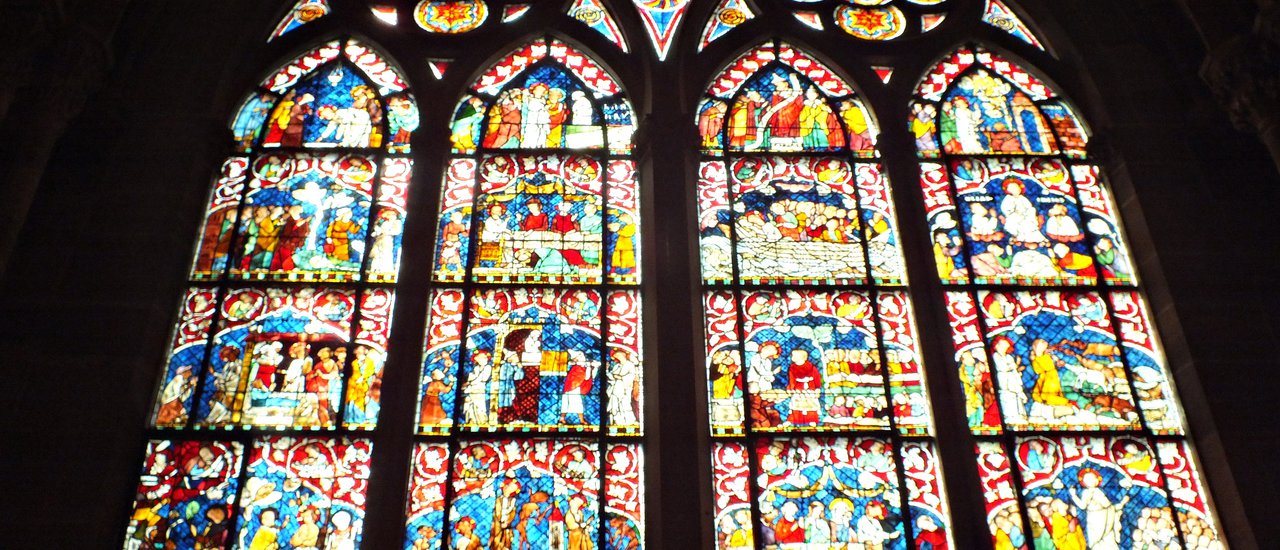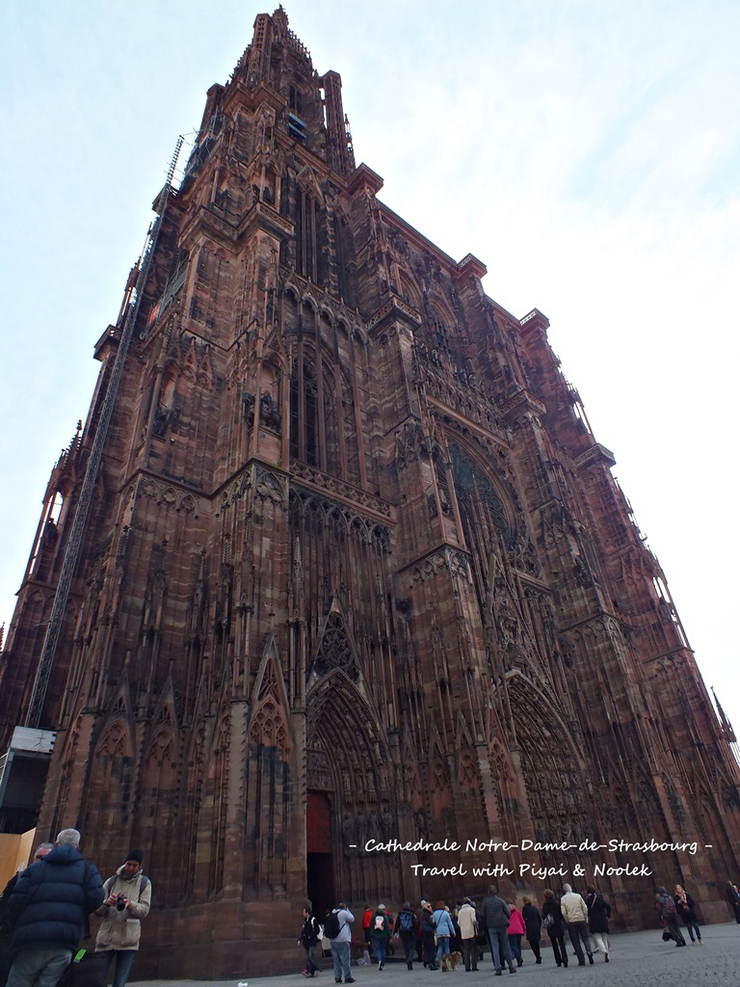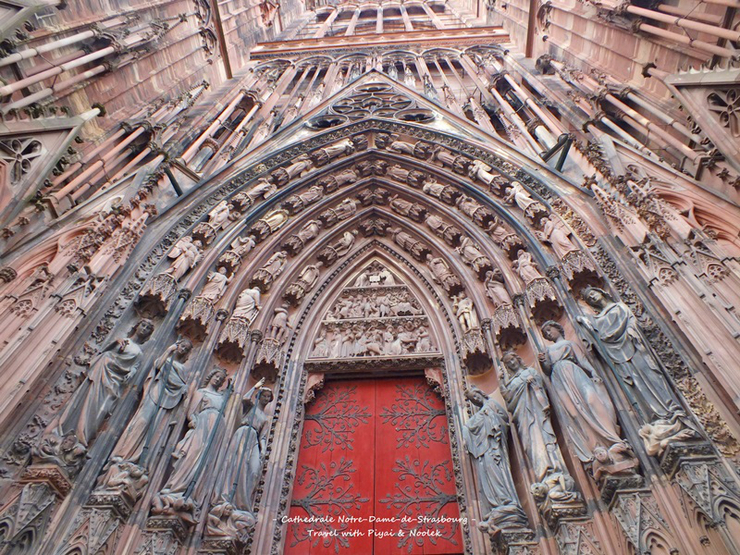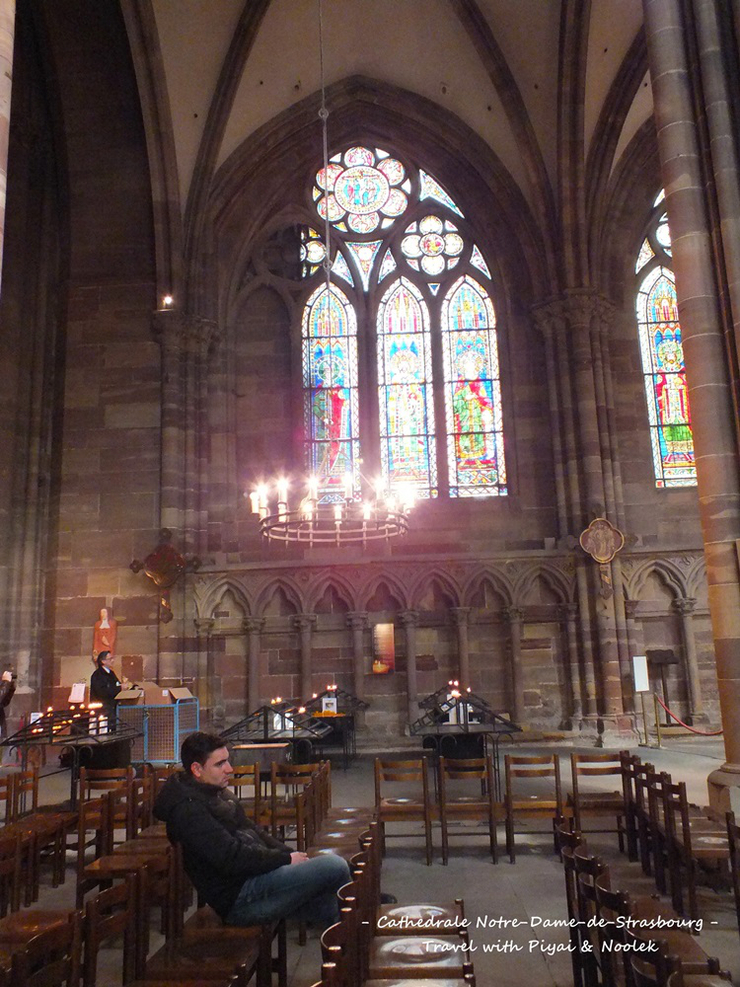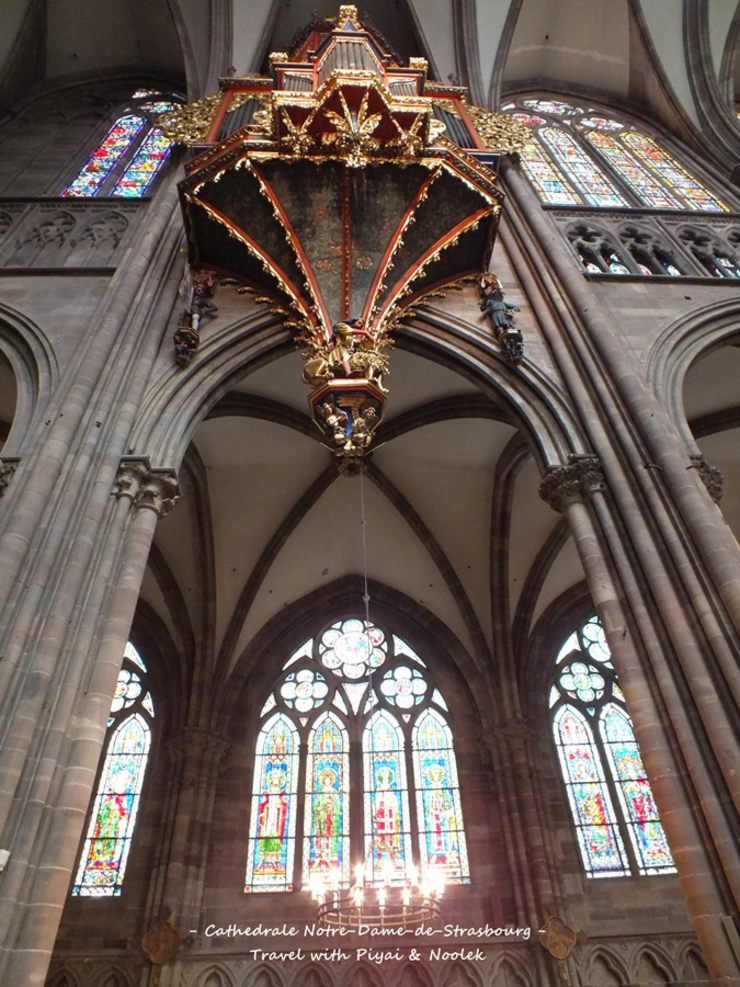
Strasbourg Highlights: A Must-See Destination
Continuing from our previous episode, we'll delve into the captivating highlights of Strasbourg, a city brimming with historical and architectural treasures.
If you're visiting Strasbourg, neglecting to explore this remarkable destination would be a significant oversight. Consider this a gentle reminder, not a stern warning, to prioritize this location on your itinerary.
Our fearless leader volunteered to safeguard our belongings while we embarked on an exploration of the interior. Be warned, attempting to enter with luggage in tow might result in a swift expulsion. So, let's follow our guide inside, where admission is free of charge.

The towering structure that dominates the Place de la Cathédrale, demanding our gaze to the point of neck strain, is the
Cathédrale Notre-Dame-de-Strasbourg, or Strasbourg Cathedral.
(Cathédrale Notre-Dame-de-Strasbourg) translates to Cathedral of Our Lady of Strasbourg.
This magnificent Roman Catholic cathedral, considered one of the most beautiful in the world, was designed and constructed under the supervision of German architect Erwin von Steinbach
between 1277 and 1318.
The cathedral's architecture is a stunning blend of Romanesque and late Gothic styles,
constructed from pink sandstone. The exterior is adorned with intricate carvings,
including numerous figures of saints and prominent individuals. The entrance portals are also embellished with sculptures of various saints.
Once the world's tallest building, reaching a height of 142 meters,
it currently ranks as the sixth tallest cathedral globally.
It is the second tallest in France, surpassed only by Rouen Cathedral in Normandy.
Notably, it remains the tallest medieval cathedral still standing today. The cathedral was designated a UNESCO World Heritage Site.
It welcomes approximately 4 million visitors annually,
making it the second most visited cathedral in France after Notre-Dame de Paris.
From the 11th to the 15th centuries, it held the title of the tallest cathedral in Western Europe.
The original design envisioned two spires for the cathedral.
However, due to structural instability during the initial construction phase, the second spire was never built,
resulting in the unique silhouette we see today.

The vast hall of this cathedral, built in the shape of a large ship (The navf - La nef), symbolizes the journey of life.
The walls are adorned with intricate marble patterns that retain their beauty.
The magnificence comes from the stained glass windows that tell stories of Christianity.
And the Rose window, a large circular stained glass window, which represents the world and the sun, is adorned with rainbow-colored glass.
When sunlight shines through, it makes the interior look vibrant, bright, and inexplicably charming.









A must-see inside the cathedral is the Astronomical Clock (L'Horloge Astronomique),
which was created in 1547 by a skilled Swiss craftsman. It is a work of art that combines the talents of artists, designers,
mathematicians, and engineers. However, it was not used until Jean-Baptiste Schwilgue repaired it
and put it back into use around 1840. It tells time in both the ordinary way and every 15 minutes.
A human figure in the stages of life, from child to adult to old man, will come out to ring the bell in front of the skeleton.
On the upper level, a Christian missionary will come out and walk.

At 12:30 p.m. every day, there is a special time announcement. The clock uses a mechanical movement without any electricity or motors.
It is a testament to the ingenuity of the engineers of that era, when technology was not as advanced as it is today.
At 12:30 p.m., 12 Christian missionaries parade past Jesus.
After a short pause, they circle around, accompanied by the sound of a rooster crowing and the ringing of a bell three times.
At the same time, on a lower level, figures representing humans at different stages of life, from children to adults to the elderly, come out to ring a bell in front of a skeleton.
The silence of the church allows the sound to resonate throughout the church and the surrounding area, a testament to the ingenuity of the clock's creators.
Unfortunately, I was unable to stay until 12:30 p.m., as that was over an hour away.
We still had to "kill time" at other parts of Strasbourg, so I missed the special time announcement.
In addition, if you want to see the view of the city from the top of the cathedral, you can climb the stairs to the top.
It's only 332 steps, which isn't too many, and there's a small fee.
However, for me and our tour, we didn't need a high-angle view, so we didn't go up. We focused on the horizontal view instead.






The little girl, captivated by the magnificent beauty of the church, wandered around, admiring every detail. She meticulously captured every stained glass window and rose window, her heart filled with awe for the craftsmanship.
Not only was the interior impeccably beautiful, but the exterior of the cathedral itself was equally breathtaking. One could only wonder where the people of ancient times acquired such skill, to carve stone into such exquisite forms, with such delicate grace, expressions, postures, and drapery. It was truly unbelievable, a testament to the grandeur that everyone desires to witness at least once.
It was a worthwhile journey to visit this place, even if it was just a passing city.







After being thoroughly impressed by the magnificence of the cathedral,
we dragged our luggage and walked back to Place Gutenberg to continue exploring the city.
Our next destination was Petite France, which we had yet to reach.
The streets were bustling with people as it was a holiday.
Not only were there tourists, but also locals out shopping.
We walked from Place Gutenberg along the long street,
Rue du Vieux Marche' aux-Poissons, to admire the view of the L'ill River, which flows around the old town.




Strasbourg: A City of Two Cultures and UNESCO Heritage
Strasbourg, the capital of the Alsace region in France, boasts a unique blend of French and German cultures, reflecting its wechselvolle history under the alternating rule of these two nations. This rich heritage has earned Strasbourg a place on the prestigious list of UNESCO World Heritage Sites.
The city is also renowned as a university town, having hosted the renowned poet Goethe among its students. After basking in the warm sunshine and admiring the riverside views, we retraced our steps to Rue de la Douane, drawn by the vibrant allure of a local market. The lively atmosphere and colorful sights offered a glimpse into the everyday life of the city's residents, a delightful experience not to be missed.
Join us as we explore the captivating atmosphere captured by our correspondent.






Then, the eldest brother took us to the final destination of the killer (time), which is Petite France.
This area is considered an old town with canals connecting to many points.
There are many small bridges hidden in many places, and there are old-style houses lined up along the canal.
But what's cool is that the houses have the characteristics of the Alsace region, which is the wooden frame house.
That is, the wooden frame is built first, and then the plaster is applied in the middle, like making a picture frame.
And probably because it's a selling point of the city,
The villagers all decorate their houses with colorful flower pots, which are beautiful and sweet.
It is another area that visitors to this city should not miss at all.








The original text is empty. Please provide the text you want me to translate.
And so, we successfully killed time as we intended. It was time to drag our bags back to the train station again, as the car rental company that Mouse had booked online was located just outside the station building. When we went in with the documents, it didn't take long for the friendly big guy to take Big Brother, Mouse, and "Big Sister Or", one of the tour members who would now become our tour's top-ranked driver, to pick up the car at the nearby parking garage.


The Audacious Appointment of "Big Brother Or" as Our Driver
In this episode, I'd like to introduce you to the audacious exploits of "Big Brother Or," our tour group's first-ever passenger-turned-driver.
One might say that Big Brother and I were incredibly bold to entrust him with this crucial responsibility, considering his complete lack of experience driving left-hand-drive vehicles or navigating European roads.
Yes, you read that correctly. If you're unsure, feel free to reread it.
However, there is a rationale behind this decision.
Our current European adventure is a small group tour where everyone is expected to contribute in some way. Big Brother and I are the masterminds behind this trip, having meticulously planned and prepared everything beforehand.
Upon arrival, we will be responsible for guiding the tour, providing assistance, and ensuring everyone has a smooth experience.
As for our fellow travelers, upon arrival, they will each be assigned specific responsibilities based on their individual strengths and presumed expertise. Other tasks will be delegated as needed.
Therefore, the driving duties, initially intended for me, have been handed over to Big Brother Or, who, despite his lack of European driving experience, boasts extensive experience navigating the bustling streets of Bangkok.
This three-day trial by fire will serve as a valuable test run for future trips. If he passes this challenge, Big Brother and I can confidently move forward with planning our next adventure.
As you can see, this decision was not made on a whim. I will gradually reveal more details about the other tour members in subsequent episodes.

After receiving the Citroen Picasso that we had booked, we were ready to hit the road.
My brother asked me to get familiar with the car by driving around the parking lot.
It took us about 20 laps before we decided that was enough.
If we kept driving in circles, we would probably get dizzy before we even started our journey.
So, we decided to take the fast track and head straight for the main road. We figured we would gain experience as we encountered real-world situations.
This was our own plan, with my brother and I as the directors and navigators. We were sure we would make it (hopefully).
After leaving the parking garage and picking up the other two tour members with their luggage, we set the GPS for our destination: Colmar.
We set off on the A35 highway, which according to the plan, would take about 50 minutes, not including getting lost.
Which is normal, and we were prepared for the possibility that it might take even longer.
No problem, we just need to be patient and give the driver some time to get used to the car.
As for how long it will take, please stay tuned. I assure you it will be as I expect (haha...).

Our new adventure in France begins again.
Let's follow along to see if this new driver can get us to our destination safely.
Meanwhile, the sky is not cooperating and it has started to rain lightly. This adds another layer of difficulty to our journey.
Will we be able to sleep at the accommodation we booked tonight, or will we have to sleep in the car by the side of the road somewhere? Stay tuned to find out.
Visit our photos from the trip and say hello to Piyai and Noolek at
https://www.facebook.com/TravelWithPiyaiAndNoolek/
Piyai&Noolek
Friday, September 27, 2024 10:22 AM

